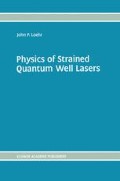Abstract
In this chapter, we present a quantum-mechanical description of the interaction of light with electrons. Although the stimulated emission and absorption of light can be treated accurately using a classical description of the electromagnetic field, the spontaneous emission of light only emerges from a quantum-mechanical description of the field. When treated in its full relativistic glory, this comprises the topic of quantum electrodynamics, which is quite detailed and difficult indeed. We will only present the nonrelativistic rudiments of this subject, but will obtain sufficient results to describe the emission and absorption of photons by semiconductors. We will arrive at the useful results as quickly as possible, and will not give a complete account of all the subtleties of quantum electrodynamics. The final expressions will be easy to use, although the philosophical interpretation of the results is a rather deep subject, into which we will not delve.
Access this chapter
Tax calculation will be finalised at checkout
Purchases are for personal use only
Preview
Unable to display preview. Download preview PDF.
Notes
It is useful to consider the continuous limit of a beaded string in visualizing the degrees of freedom of a field.
If we consider optical microcavities. where each spatial dimension is on the order of the relevant wavelength, then this plane-wave approximation is insufficient, and we must expand the vector potential in terms of the cavity modes. The resulting microcavity effects are discussed in H. Yokoyama and K. Ujihara, Spontaneous Emission and Laser Oscillation in. Microcavities. (CRC Press, 1995).
See, for example, J. D. Jackson, Classical Electrodynamics. (Wiley, New York, 1975).
A rather cavalier acceptance of infinities becomes essential when studying quantum electrodynamics.
Technically, the kets in (5.55) are not. merely abbreviations of those in (5.54), but represent fully-symmetrized Slater permanents of the individual states in (5.54). (A permanent of.states represents the same linear combination as a determinant, but. with all plus signs.) This complication is deemed necessary when we wish to view each mode as a particle, the photon. Then since all photons are identical and.satisfy Boso statistics in view of (5.48), one must fully symmetrize the photon wavefunction in accordance with the rules of many-particle quantum mechanics. These considerations will be completely irrelevant for us. Indeed, the Bose-particle picture of electromagnetic field quanta is largely a matter of philosophical-rather than computational interest.
Several subtle points must be considered when constructing this Hamiltonian. Its derivation is outside the scope of this text. The most obvious change is to replace p → p → A, a standard result from classical Hamiltonian mechanics. But the reemergence of the scalar potential must be treated in detail. At first sight it seems like an error, since we have already set Φ = 0 when deriving the radiation Hamiltonian. In fact it is not. For details see J. J. Sakurai, Advanced Quantum Mechanics. (Addison-Wesley, London, 1967).
Do not. confuse with Ĥkα as defined in (5.50).
Note that the angles θ and ø refer to the photon wavevector k, not the electron coordinate r.
Author information
Authors and Affiliations
Rights and permissions
Copyright information
© 1998 Springer Science+Business Media New York
About this chapter
Cite this chapter
Loehr, J.P. (1998). Interaction of Matter and Radiation. In: Physics of Strained Quantum Well Lasers. Springer, Boston, MA. https://doi.org/10.1007/978-1-4615-5673-2_5
Download citation
DOI: https://doi.org/10.1007/978-1-4615-5673-2_5
Publisher Name: Springer, Boston, MA
Print ISBN: 978-0-7923-8098-6
Online ISBN: 978-1-4615-5673-2
eBook Packages: Springer Book Archive

